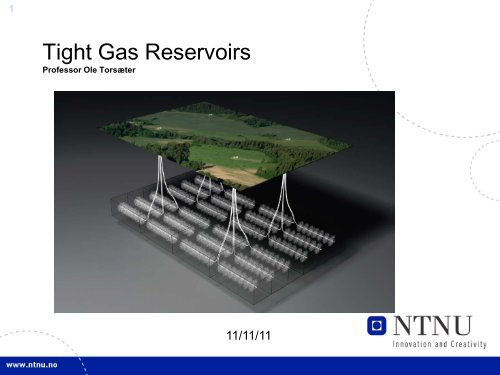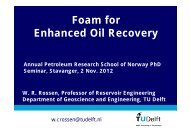Reservoir engineering aspects of tight gas reservoir evaluation
Reservoir engineering aspects of tight gas reservoir evaluation
Reservoir engineering aspects of tight gas reservoir evaluation
- No tags were found...
Create successful ePaper yourself
Turn your PDF publications into a flip-book with our unique Google optimized e-Paper software.
1Tight Gas <strong>Reservoir</strong>sPr<strong>of</strong>essor Ole Torsæter11/11/11
2Unconventional natural <strong>gas</strong> resourcesWhat is really considered unconventional natural <strong>gas</strong> changeswith time. However, there are six main categories <strong>of</strong>unconventional natural <strong>gas</strong>:• Deep <strong>gas</strong>• Tight <strong>gas</strong>• Gas-containing shales• Coalbed methane• Geopressurized zones• Hydrates
3Resource PyramidLarge VolumesSmall VolumesGasShalesHighQualityMediumQualityTightGasLowQuality1000 md100 md1 md0.1 mdCoalbedMethane0.001 mdIncreased DemandBetter Technology0.0001 mdContinued Drilling and Development
6Tight natural <strong>gas</strong>• Permeability less than 0.1md(1*10 -16 m 2 )• Porosity approx. 5-15%• Limestone or sandstoneformations• Not readily extractable. We mustput more effort into theextraction process than forconventional <strong>gas</strong> <strong>reservoir</strong>s; likefracturing, acidizing etc.
7Shale <strong>gas</strong>• In Devonia shales (formed in shallow seas more than350 million years ago).• Permeability in the nanoDarcy range (10 -9 D or 10 -21m 2 )• Difficult to produce due to the properties <strong>of</strong> shale andtherefore the expected recovery <strong>of</strong> the <strong>gas</strong> is low.• Shale <strong>gas</strong> is found all over the world.
8Shale <strong>gas</strong>
9Statoil1,8million acres=7300km 2From Statoil.com
10The Marcellus Shale• Organic rich shale at a depth <strong>of</strong> approx. 1000m• The <strong>gas</strong> occurs in three ways:– Within the pore space <strong>of</strong> the shale– Within fractures (vertical) and joints in the shale– Adsorbed on mineral grains and organic materials• Most <strong>of</strong> the recoverable <strong>gas</strong> is contained in the porespace.• Natural fracture system is important for wellproductivity.
11Coalbed methane• Many coal formations (seams) contain natural <strong>gas</strong>,either within the seams itself or the surrounding rock.• What was once a by-product <strong>of</strong> the coal industry isbecoming an increasingly important source <strong>of</strong>methane and natural <strong>gas</strong>.
12Productivity <strong>of</strong> <strong>tight</strong> <strong>gas</strong><strong>reservoir</strong>s
13Presentation Summary• Some additional information about <strong>tight</strong> <strong>gas</strong><strong>reservoir</strong>s• Conditions generally required for economic <strong>tight</strong> <strong>gas</strong><strong>reservoir</strong> production• Common formation damage types occurring in <strong>tight</strong><strong>gas</strong> <strong>reservoir</strong>s
14‘Conventional’ vs 'Unconventional'Accumulations• Characteristics <strong>of</strong> ‘Conventional’ Accumulations– Relatively high matrix permeability– Obvious seals and traps– High recovery factors• Characteristics <strong>of</strong> ‘Unconventional’ Accumulations– Regional in extent– Diffuse boundaries– Low matrix permeabilities– Low recovery factors– Productivity <strong>of</strong> a <strong>tight</strong> <strong>gas</strong> <strong>reservoir</strong> is only 25% <strong>of</strong> <strong>gas</strong> in place in the best case(average 10-15%). Gas connectivity only in 4% <strong>of</strong> porosity.From John Lee (Texas A&M University)Advances in Unconventional Resources Technology: Assessment Methodology
15What controls the ability toeconomically produce <strong>tight</strong> <strong>gas</strong>reserves?• Effective permeability to <strong>gas</strong>• Initial saturation conditions• Size <strong>of</strong> effective sand face drainage area accessed bythe completion• <strong>Reservoir</strong> pressure• Degree <strong>of</strong> liquid dropout from <strong>gas</strong> (rich vs. dry <strong>gas</strong>)
16Capillary equilibrium in <strong>gas</strong><strong>reservoir</strong>s – High PermCapillary Pressure - PsiRelative PermeabilityFWCWater SaturationWater SaturationBrant Bennion, presentation at Canadian Well Logging Society
17Capillary equilibrium in <strong>gas</strong><strong>reservoir</strong>s – LOW PermCapillary Pressure - PsiRelative PermeabilityFWCWater SaturationWater SaturationBrant Bennion, presentation at Canadian Well Logging SocietyJune 9, 2004
18Generally if a <strong>tight</strong> <strong>gas</strong> matrix is inequilibrium with a free watercontact,→equilibrium water saturationreduces reserves and effectivepermeability to <strong>gas</strong> below theeconomic limit for production
19Non - capillary equilibrium in <strong>gas</strong><strong>reservoir</strong>s – LOW PermCapillary Pressure - PsiRelative PermeabilityNO FWCWater SaturationWater SaturationBrant Bennion, presentation at Canadian Well Logging Society
20For significant reserves and mobile <strong>gas</strong>production in very low perm <strong>gas</strong><strong>reservoir</strong>s,a CAPILLARY SUBNORMAL watersaturation condition usually must existWater Gauge
21Subnormally water saturated <strong>tight</strong><strong>gas</strong> <strong>reservoir</strong>s:• A <strong>gas</strong> <strong>reservoir</strong> in which the initial water saturation isless than that which would be achieved on aconventional drainage capillary pressure curve at theeffective capillary gradient <strong>of</strong> the <strong>reservoir</strong>
22Some interesting <strong>aspects</strong> <strong>of</strong> <strong>tight</strong><strong>gas</strong> relative permeability.
23Relative permeability <strong>of</strong> <strong>tight</strong> <strong>gas</strong> <strong>reservoir</strong>sDemonstration cross-plot <strong>of</strong> drainage and imbibition <strong>gas</strong>-water relativepermeability.
24Comparison <strong>of</strong> relative permeability between conventional andunconventional <strong>gas</strong> <strong>reservoir</strong>Conventional <strong>reservoir</strong>Unconventional <strong>reservoir</strong>Conventional <strong>reservoir</strong>: wide range <strong>of</strong> water saturation where both water and<strong>gas</strong> can flow.Unconventional <strong>reservoir</strong>: broad range <strong>of</strong> water saturation in which neither <strong>gas</strong>nor water can flow.Shanley et al. AAPG Bulletin 2004
25Numerical studyNote crossover, where krg=krw isapproximately 67% for all permeabilities butkrg value at crossover decreases withdecreasing permeability. Dark blackhorizontal line marks the krg = 2% (0.02).The Sw region where both <strong>gas</strong> and waterhave kr < 0.02 broadens as k ik decreases.
26Capillary pressure <strong>of</strong> <strong>tight</strong> <strong>gas</strong> <strong>reservoir</strong>Comparison <strong>of</strong> capillary pressure between conventional andunconventional <strong>gas</strong> <strong>reservoir</strong>Shanley et al. AAPG Bulletin 2004
27Relationship between capillary pressure, relative permeability andposition within a trap.Shanley et al. AAPG Bulletin 2004
28Shanley et al. AAPG Bulletin 2004
29Fracturing <strong>of</strong> <strong>tight</strong> <strong>gas</strong> <strong>reservoir</strong>s.
31Performance <strong>of</strong> fractured wells in <strong>tight</strong> <strong>gas</strong> <strong>reservoir</strong>s.Frac technique: horizontal well withmultiple fracturesTest rate: 14,000 m 3 /h vs 4,000 m 3 /h withouttechnologySeven Fracture system ready to open sliding sleeves3.5 increase in well productivityFrom Gaz de France
32Causes <strong>of</strong> productivity loss <strong>of</strong>fractured wells in <strong>tight</strong> <strong>gas</strong> formation• Rheological fluid properties (affectfracture length)• Polymer residus in the fracture (affectfracture conductivity)– with cross-linked fluids– up to 90% <strong>of</strong> conductivity loss– optimization <strong>of</strong> cleaning fluids like"breakers"• Filtration (affects <strong>reservoir</strong> properties)– fracturing fluid invasion into the<strong>reservoir</strong> (decrease <strong>of</strong> the fracturelength, <strong>reservoir</strong> damage around thefracture)• Water blocks (affect <strong>gas</strong> back flow)– decrease the <strong>gas</strong> permeability
33Water blocks investigation.Aim:• Simulation <strong>of</strong> the filtration <strong>of</strong> the fracturingfluid and <strong>evaluation</strong> <strong>of</strong> damage.Method• Cores at Swi (<strong>gas</strong>)• Fracturing fluid filtration with 200 bars oncore face• Gas backflow at various pressures• Water blocks identified by XRayacquisitionResults• Water saturation pr<strong>of</strong>iles• Gas return permeabilityConditions <strong>of</strong> the equipment• Direct measurement <strong>of</strong> water blocks byXRay• Temperature: 130°C, Pressure 330 barsFracturing fluid filtration200 barsGas Back flow5, 10, 15 bars
34Flow rig at Institut Francais du Petrol.x-rayfluidscore holderTmax =130°C (210°F)Pmax=330bar (4700psi)
35Workflow for improved predictionsFracturing fluid selection- Lab studyfiltration, absolute permeability damage,measurement <strong>of</strong> in situ saturation (waterblocks), petrophysics (capillary curves)Modeling at laboratory scale<strong>Reservoir</strong> and fracturedescriptionModelling parameterscake properties, absolute permeabilityreduction, relative permeability curvespermeability hysteresisNear Wellbore SimulatorWell Productivity Evaluation
36Conclusions•Tight <strong>gas</strong> <strong>reservoir</strong>s have a huge future potentialfor production.•Generally to be economic <strong>tight</strong> <strong>gas</strong> <strong>reservoir</strong>s arenormally in a subnormal water saturation condition.•Fluid trapping (water blocks) tends to be adominant damage mechanism for <strong>tight</strong> <strong>gas</strong><strong>reservoir</strong>s.•Productivity prediction is almost impossiblewithout detailed petrophysics data measured inrepresentative conditions (stress, hysteresis,capillary pressure...)






